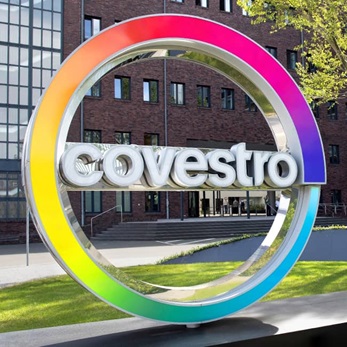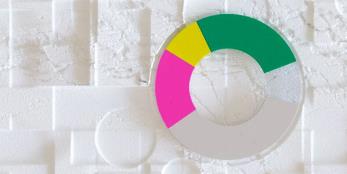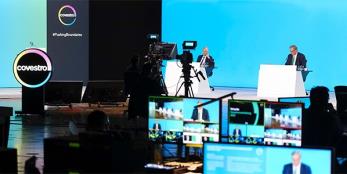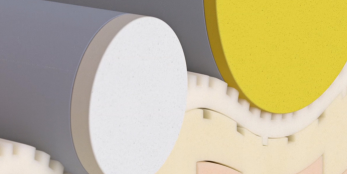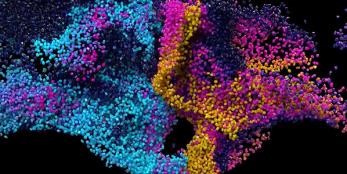Before working with this product, you must read and become familiar with the available information regarding its risks, proper use, and safe handling. This information is provided in various formats, including the current Safety Data Sheet (SDS) and product label. SDS can be accessed via the following link:
Safety Data Sheets (SDS) for Covestro products | Covestro
For further questions, please use the contact information provided on this technical data sheet.
Product description
Bayfol® HX200 is a light-sensitive, self-developing photopolymer film which can be used to produce phase holograms in the form of volume reflection and volume transmission holograms. Bayfol® HX200 can be recorded with appropriate laser light within the visible spectral wavelength range from 440 nm to 680 nm. For hologram formation no further post-treatment is necessary, e.g. neither wet nor thermal treatment. Bayfol® HX200 consists of a three layer stack of a substrate, a light-sensitive photopolymer and a protective cover film. The substrate is a cellulose triacetate film (TAC), and the protective cover is a polyethylene film (PE). The protective cover film can be removed from the photopolymer.The product is capable of being used for a variety of types of volume holograms. Layer Stack, Schematic
Typical Values
Optical Properties
| Property | Test Condition | Value | Unit | Standard |
|---|---|---|---|---|
| Effective thickness shrinkage | after recording and UV flood cure 2) | approx. 1,4 | % | Reflection holograms |
| Typical substrate thickness | 60 | microns | acc. to ISO 4593, 23°C | |
| Typical photopolymer thickness | 16 | microns | white light interferometer | |
| Typical cover layer thickness | 40 | microns | acc. to ISO 4593, 23°C | |
| Recording dosage | (needed to achieve above mentioned values) | approx. 30 | mJ/cm² | Recording wavelenght: λ = 532 nm; Power density: PR= 4.6 mW/cm² |
| Typical recording dosage needed to achieve above ∆n1 values | ||||
| Light transmittance | Unrecorded film, w/o cover foilSee spectrum in the appendix | % | ASTM E 01348 | |
| Maximum refractive index modulation ∆n1 per recording wavelengt λ | ISO 17901-2 | |||
| Spectral diffraction efficiency η | > 95 | % | ISO 17901-1, by transmittance of zero-order transmitted wave | |
| Haze | after UV flood cure 2) | < 2 | % | ASTM D 1003 |
| Spectral bandwidth | (full width at half maximum) | > 15 | nm | ISO 17901-1, by transmittance of zero-order transmitted wave |
| Spectral shift | after recording and UV flood cure 2) | approx. -8 | nm | Denisyuk Holograms: wavelength deviation between recording / reconstruction |
| λ = 633 nm | > 0,03 | |||
| Index of refraction nD of the substrate | 1,485 | Prism coupler | ||
| λ = 532 nm | > 0,03 | |||
| Index of refraction nD of the photopolymer | unrecorded | 1,500 | Prism coupler | |
| λ = 457 nm | > 0,03 | |||
| Index of refraction nD of the photopolymer | after UV flood cure 2) | 1,505 | Prism coupler | |
| λ = 633 nm | Applied total dosage | approx. 15 | mJ/cm² | |
| λ = 532 nm | Applied total dosage | approx. 20 | mJ/cm² | |
| λ = 457 nm | Applied total dosage | approx. 25 | mJ/cm² |
Storage
The unrecorded photopolymer film should be stored in the original and sealed Covestro container that is used for delivery, whenever possible.The storage temperature shall be kept at ≥15°C and ≤ 25 °C.While the recorded film is quite stable, the unrecorded photopolymer film should be protected from light, humidity, heat and foreign materials.
Storage time
Six months Storage Time is recommended.
Processing
General information about handling instructions under dark room conditions:The product is light sensitive. Exposure to light prior to the holographic exposure might sacrifice the refractive index modulation Δn1 and diffraction efficiency η. Examples for tolerable expositions in dark room environment (dim yellow light) without sacrificing the holographic performance are given below:
Transmissions spectrum of the unrecorded photopolymer film.The transmission spectrum of the unrecorded photopolymer film was recorded after removal of the protective cover film.The measurement is done in a darkened laboratory with a spectrometer according to ASTM E 01348.
General information for flood cure and bleaching:These are recommendations and should serve as guidelines. According to the specific equipment components and the type of product to be produced, deviations from these guidelines might be necessary. The bleaching can also be adapted to the required product performance. Example: Conditions for mercury lamps High temperatures (above 60°C at the film) should be avoided because they can lead to deformation of the substrate. Dichroic mirrors that reflect UV-light and transmit IR-radiation and a fused silica panel in front of the lamp can reduce the amount of IR-radiation and thus further reduce the temperature.The following conditions were found to be favorable:• Photopolymer layer on substrate laminated to glass• Dosage: 5,000-10,000 mJ/cm²• Intensity at the sample: 40 mW/cm²These data were found using a mercury lamp (MH-Strahler UV-400 H) of Hönle UV Technology (http://www.hoenle.de).
Health and Safety Information
Disclaimer
Responsibility and Liability
The use of Covestro products, technical assistance, and information (regardless of how provided) is outside Covestro’s control and is solely the responsibility of the customer. The customer must conduct adequate testing to determine the suitability of products for its intended use, including but not limited to technical, health, safety, and environmental aspects. Unless otherwise agreed in writing, all products are sold exclusively under Covestro’s standard conditions of sale, which prevail in case of conflict and are available upon request.
The terms and conditions of sale and delivery are available via the following link:
https://order.covestro.com/covestrostorefront/saleConditions
All information is provided “as is” without warranties, express or implied, including merchantability or fitness for a particular purpose, and is subject to change without notice. To the maximum extent permitted by law, Covestro disclaims, and the customer assumes all liability for losses, damages, or claims arising out of use of Covestro products, technical assistance, or information. Any statement or recommendation not expressly contained in Covestro documentation is unauthorized and shall not bind Covestro. Nothing herein shall be construed as encouraging or recommending the use of any product in conflict with any claim of any patent. No license is implied or in fact granted under the claims of any patent.
Restrictions on Regulated Applications
This product is not intended for use in regulated applications such as agriculture, cosmetics, drinking water contact, food contact, medical products (e.g., medical devices), toys, or similar uses subject to specific regulatory requirements. Prior written approval from Covestro is required before this product may be used in any regulated application. The customer is solely responsible for ensuring compliance with all applicable laws and determining product suitability. Covestro disclaims all liability and warranties for unauthorized regulated uses.
Typical Value
These values are provided as typical data only and do not constitute binding specifications or warranted performance, unless explicitly agreed by Covestro in writing. Performance may vary depending on factors including, but not limited to, mold/die, processing conditions and coloring/pigmentation. Unless otherwise stated, values are based on standardized test specimens at room temperature.
Sample
Samples provided by Covestro are intended solely for evaluation and testing purposes by the customer and may not be used in commercial applications, resold, transferred to third parties (except qualified testing service providers acting on behalf of the customer), reverse engineered, modified, or used in any manner not explicitly authorized in writing by Covestro. Samples are provided ‘as-is’ without any warranties, express or implied, including fitness for a particular purpose. Customers are solely responsible for ensuring safe handling, regulatory compliance, and suitability of the material for their intended evaluations. Covestro disclaims all liability for damages or losses arising from the use of samples.
Contact Information
Please use our contact form or contact us directly by sending an e-mail to technical-datasheets@cx.covestro.com .

